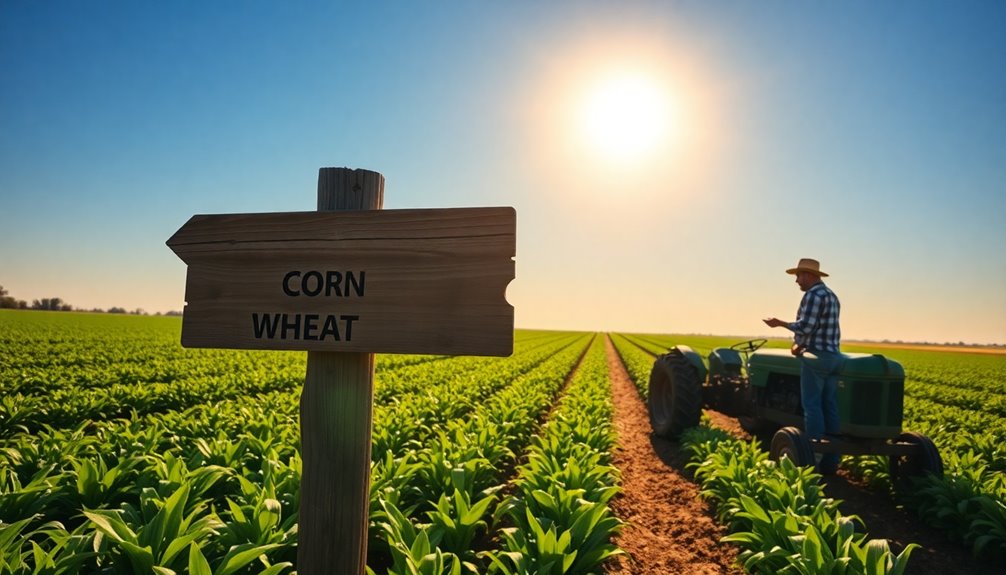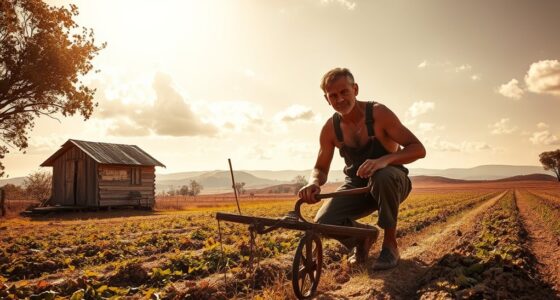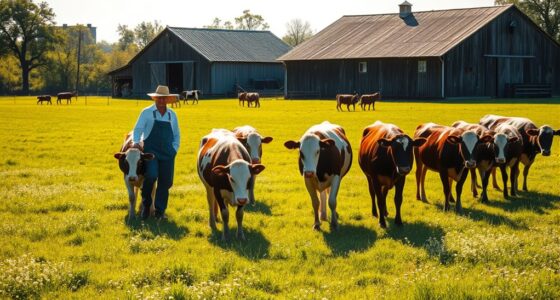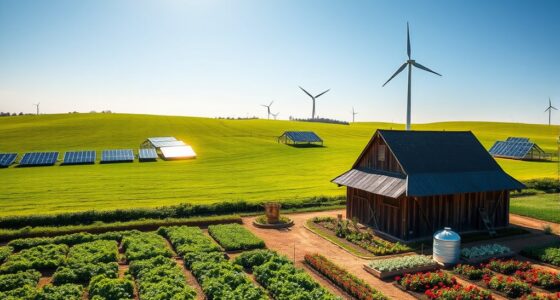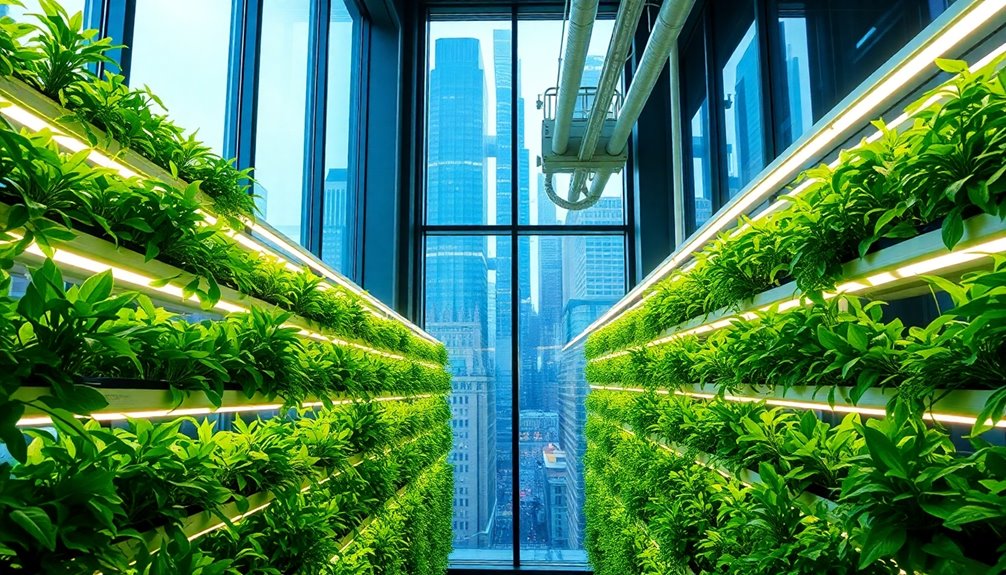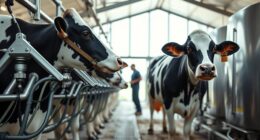You can find contour farming and terracing in stunning locations like the Banaue Rice Terraces in the Philippines and the ancient sites of Machu Picchu in Peru. These areas leverage the land's natural contours to reduce soil erosion and optimize water use. Other notable spots include the Longji Rice Terraces in China and regions in the Appalachian Mountains of the USA. Each location illustrates the benefits of these sustainable practices that thrive in hilly terrains. Explore these remarkable farming methods further, and you'll uncover even more fascinating insights and examples of successful contour farm practices around the world.
Key Takeaways
- The Banaue Rice Terraces in the Philippines are a UNESCO World Heritage Site known for advanced irrigation and stunning landscape design.
- Machu Picchu in Peru showcases ancient terraces that maximize agricultural land in steep mountainous regions.
- Longji Rice Terraces in China feature traditional farming practices dating back to the Yuan Dynasty, optimizing hillside agriculture.
- The Appalachian Mountains in the USA exemplify effective contour farming to reduce soil erosion and enhance water retention.
- The Loess Plateau in China demonstrates successful contour farming techniques that boost agricultural productivity in eroded areas.
Overview of Contour Farming
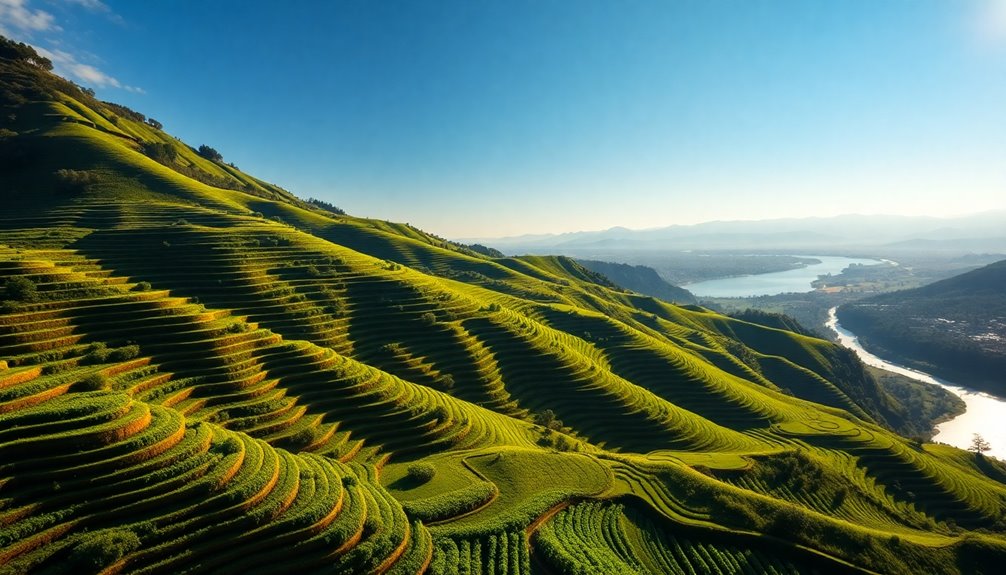
When you consider effective farming techniques, contour farming stands out as a sustainable method that aligns with the land's natural contours. This soil conservation practice involves plowing and planting across slopes, which greatly reduces soil erosion and enhances water conservation.
By following the land's shape, you can decrease erosion rates by up to 50%, making it essential for maintaining agricultural productivity. Contour farming utilizes furrows, crop rows, and wheel tracks as reservoirs, improving water infiltration and distribution across fields.
Originating in ancient irrigation regions, it gained traction in the U.S. during the 1930s for erosion control. Additionally, contour farming works harmoniously with terrace farming practices and other methods, promoting overall soil health and sustainability in agriculture.
Key Locations for Terracing
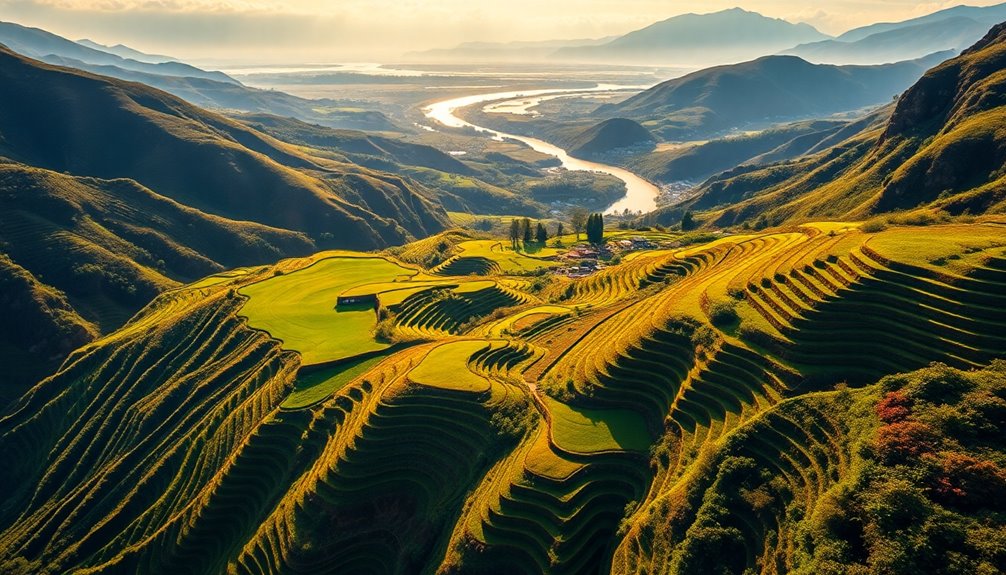
Numerous locations around the world exemplify the beauty and utility of terracing in agriculture.
These key sites not only showcase stunning landscapes but also serve essential functions in food production and sustainable practices.
- Banaue Rice Terraces, Philippines: A UNESCO World Heritage Site with a sophisticated irrigation system.
- Machu Picchu, Peru: Ancient terraces that optimize agricultural land in rugged terrain.
- Longji Rice Terraces, China: Known for their breathtaking views and traditional farming from the Yuan Dynasty.
In these mountainous areas, terracing effectively reduces soil erosion, conserves soil and water, and maximizes agricultural land usage.
Global Examples of Contour Farming
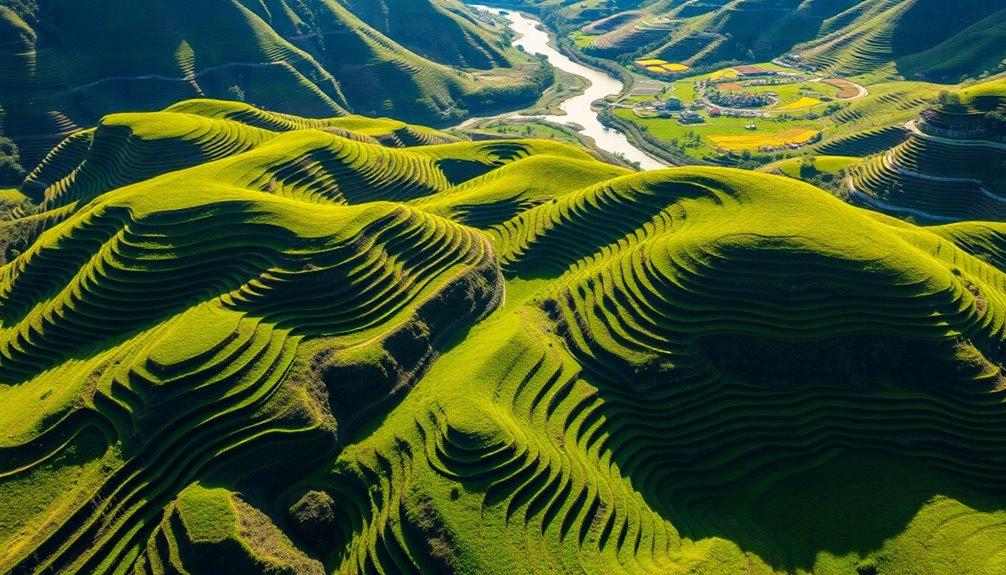
Contour farming is a vital agricultural practice that has gained traction in various hilly regions around the globe. In the Appalachian Mountains of the United States, this method effectively reduces soil erosion and enhances water retention on slopes.
The Loess Plateau in China highlights how contour farming contributes to soil conservation and boosts agricultural productivity in areas facing severe erosion.
In Brazil, particularly in Santa Catarina and Rio Grande do Sul, farmers utilize contour farming to improve crop yields while minimizing environmental degradation.
The Andes Mountains in Peru showcase traditional contour farming among local communities, allowing them to cultivate steep terrains.
Additionally, in East Africa, countries like Kenya and Ethiopia employ this technique to combat soil erosion and improve water management in hilly areas.
Benefits of Ideal Farming Locations
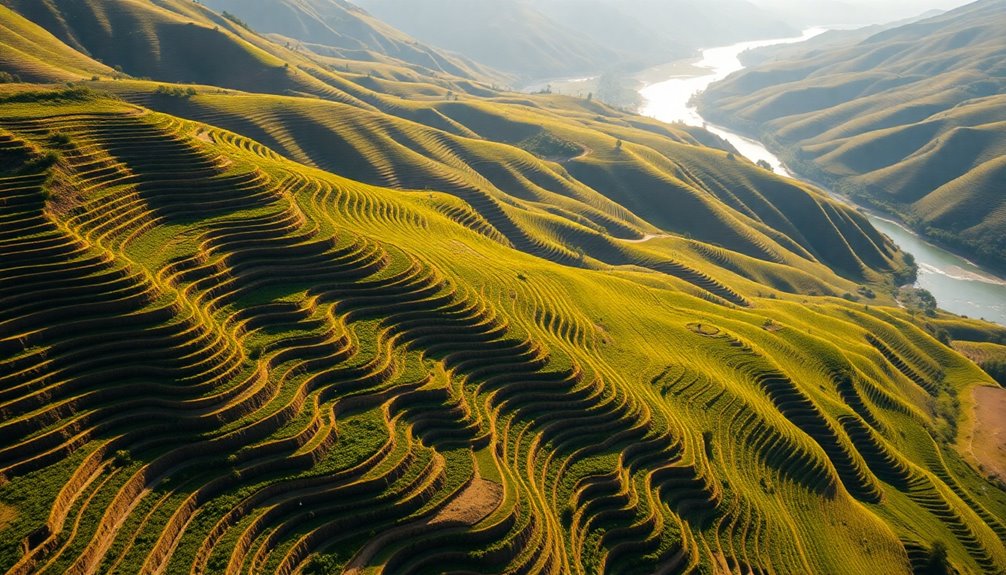
Choosing the right locations for contour farming and terracing can greatly enhance agricultural practices. By targeting sloped lands, you can greatly reduce soil erosion and improve water management.
Here are some benefits of ideal farming locations:
- Reduce soil erosion by up to 50%
- Enhance water retention on slopes
- Maximize agricultural productivity in diverse topographies
When you implement contour farming and terracing in regions with gentle to moderate slopes, you'll find it easier to maintain soil health and manage water flow.
Especially in areas that experience heavy rainfall, these practices can minimize surface runoff and prevent soil degradation.
Over time, this leads to improved crop yields and sustainable farming, ensuring long-term viability for your agricultural endeavors.
Climate Considerations for Contour Practices

When considering climate factors for contour farming, understanding your local environment is essential. Effective contour practices thrive on sloped land with moderate to high rainfall, promoting soil moisture and crop growth. Regions facing climate variability, such as parts of Africa and South Asia, benefit from contour farming to enhance water management and combat drought. In tropical climates, where heavy rains increase soil erosion, using contour farming techniques is vital to sustain agricultural productivity.
| Climate Type | Key Characteristics | Benefits of Contour Farming |
|---|---|---|
| Moderate to High | Consistent precipitation | Enhances soil moisture retention |
| Tropical | Heavy rainfall and erosion concerns | Mitigates soil erosion |
| Variable | Inconsistent weather patterns | Improves water management |
Soil Types Favoring Terracing

Effective soil management plays a pivotal role in the success of terracing practices. Choosing the right soil types is vital for preventing erosion and maximizing fertility.
Here are some key factors to take into account:
- Clayey and loamy soils are best for their structure and water retention capabilities.
- Good drainage is essential to avoid waterlogging, promoting healthier crops.
- High organic matter content enhances soil fertility and nutrient retention.
Terracing is typically effective on slopes with a gradient of 3% to 8%, where these soil types can maintain structural integrity.
Aim for soils with a pH range of 6.0 to 7.5 to guarantee adequate nutrient availability.
Regions With Steep Slopes
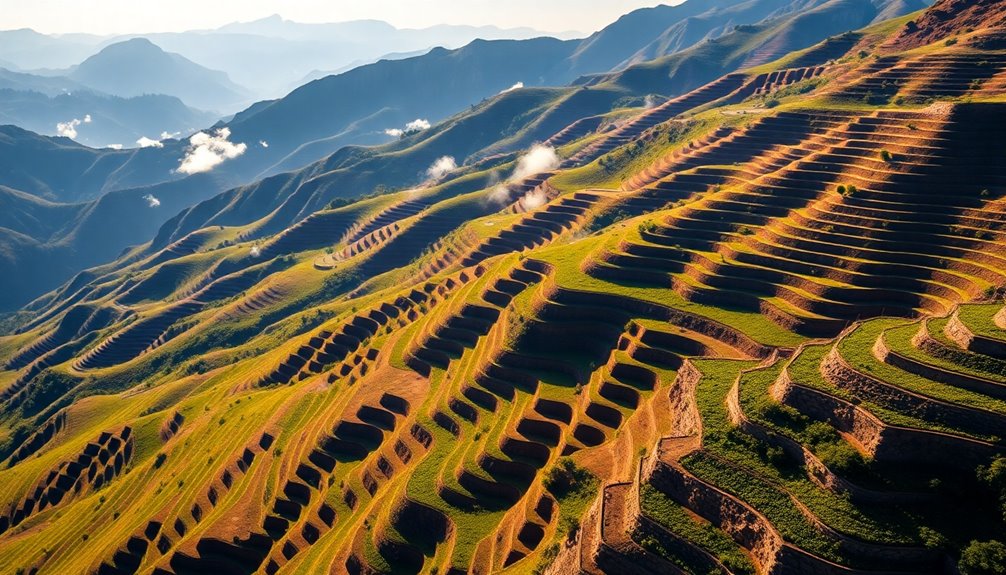
Across the globe, regions with steep slopes present unique challenges and opportunities for agriculture. In places like the Andes Mountains, farmers have long utilized contour farming and terrace farming to grow crops such as potatoes and maize.
The Banaue Rice Terraces in the Philippines highlight how effective terracing can be in high-altitude areas, supporting rice cultivation while reducing soil erosion. Similarly, Vietnam's Northern Highlands leverage steep slopes for diverse crops, enhancing water retention and minimizing erosion.
In Ethiopia's highlands, terrace farming boosts agricultural productivity of cereals and coffee. Meanwhile, in the Himalayan region, farmers employ contour farming techniques, maximizing arable land on steep slopes while mitigating soil erosion risks.
Historical Context of Terracing
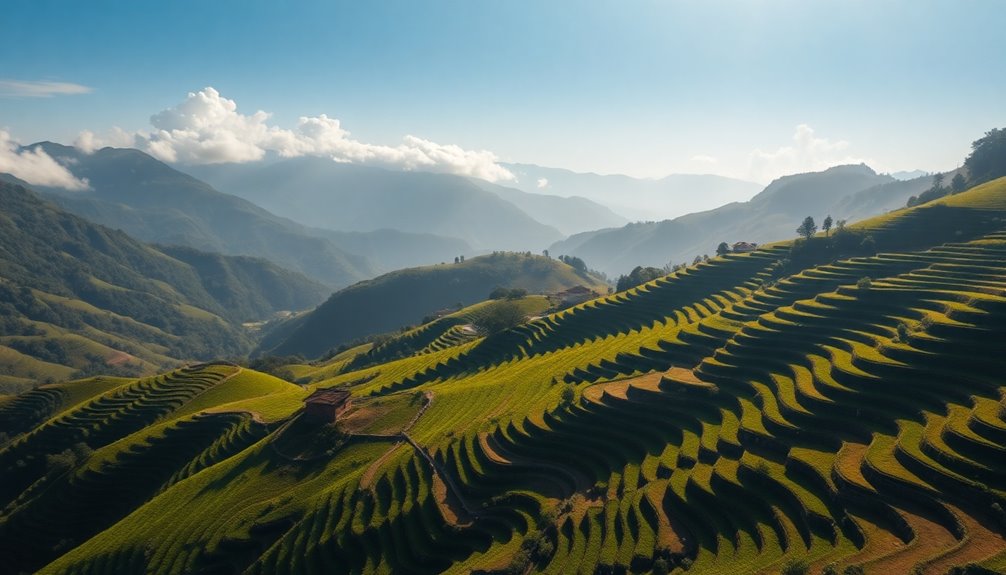
Terracing has roots that stretch back over 2,000 years, reflecting the ingenuity of ancient agricultural practices.
As you explore its cultural significance, you'll see how societies like the Incas and Chinese adapted the technique for their landscapes.
Understanding this evolution can shed light on how these methods continue to influence sustainable farming today.
Ancient Agricultural Practices
Many ancient civilizations developed innovative agricultural practices to adapt to their environments, with terracing being one of the most remarkable. This method was especially essential in irrigation-dependent regions, allowing societies like the Incas to thrive on steep slopes.
Here are some key points about ancient agricultural practices:
- Terracing maximized land use and improved water retention.
- Contour farming techniques emerged to combat soil erosion and guarantee sustainable crop yields.
- Soil conservation efforts have deep historical roots, influencing modern practices.
Cultural Significance of Terraces
The cultural significance of terraces extends far beyond their agricultural benefits; they represent a deep connection between communities and their landscapes. Terrace farming has been practiced for millennia, addressing soil erosion and enhancing agricultural production through advanced irrigation techniques. In locations like the Banaue Rice Terraces and Machu Picchu, these structures serve as symbols of cultural heritage, showcasing human ingenuity in overcoming environmental challenges. Additionally, the Sa Pa terraces in Vietnam blend agriculture with local tourism, enriching community identities.
| Location | Cultural Significance | Key Features |
|---|---|---|
| Banaue, Philippines | Ancient irrigation techniques | Over 2,000 years old |
| Machu Picchu, Peru | Engineering prowess of the Incas | Farming in steep terrain |
| Sa Pa, Vietnam | Integration with local tourism | Scenic beauty and tradition |
| Salinas De Maras, Peru | Ancient salt production | Diverse applications |
Evolution of Farming Techniques
For thousands of years, farmers have developed innovative techniques to adapt to challenging landscapes and optimize crop production.
Two pivotal methods in this evolution are contour farming and terrace farming, both addressing soil conservation and water management.
- Ancient practices date back over 2,000 years, like the Banaue Rice Terraces.
- Contour farming surged in the 1930s as a response to the Dust Bowl.
- These techniques emphasize sustainable land management to combat erosion.
Integration With Local Ecosystems
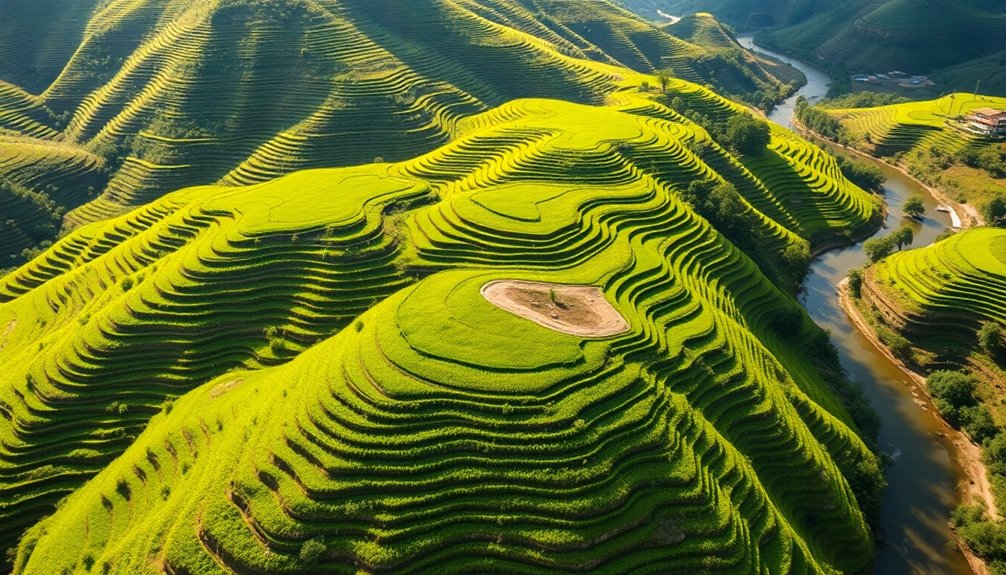
In recent years, integrating contour farming and terracing with local ecosystems has become increasingly important for sustainable agriculture. These practices thrive in hilly regions, where slopes range from 3% to 25%.
Contour farming and terracing can effectively reduce surface runoff by up to 50% in areas prone to heavy rainfall, helping preserve water in the soil for your crops. By incorporating contour buffer strips, you support biodiversity corridors that enhance wildlife habitats and stabilize soil.
Additionally, using cover crops alongside these methods boosts soil health, increasing organic matter and further promoting biodiversity.
Looking at terraced landscapes like the Banaue Rice Terraces, you can see how agriculture can harmonize with local ecosystems, maximizing land use while maintaining cultural heritage.
Future Trends in Contour Farming

As you explore the future of contour farming, you'll notice a strong push towards integrating technology, like precision agriculture tools, to enhance efficiency.
With increasing policy support for sustainable practices, you can expect more incentives encouraging farmers to adopt these methods.
Plus, adapting to climate change through innovative strategies will be vital for improving soil health and ensuring resilience against extreme weather.
Technological Integration Opportunities
Contour farming's future is closely tied to technological integration, paving the way for innovative practices that enhance sustainability and productivity. By embracing these advancements, you can markedly improve your farming methods.
Consider these key opportunities:
- Precision agriculture: Utilize digital elevation models to optimize contour lines, increasing water retention and crop yields.
- Automated guidance systems: Leverage topographic data to refine machinery paths, boosting operational efficiency.
- Satellite monitoring: Implement tools like EOSDA Crop Monitoring for real-time insights into soil conditions and crop health.
Additionally, emerging agro-geo-textiles can help reduce runoff and improve soil moisture retention. Furthermore, high refresh rates in agricultural drones can provide faster data collection and analysis, enhancing decision-making processes.
As you explore contour farming, integrating these technologies will help you adapt to climate challenges and foster sustainable agricultural practices.
Policy Support Initiatives
Support for contour farming is gaining momentum, with numerous initiatives designed to encourage sustainable agricultural practices.
Policy support initiatives are focusing on providing financial incentives and grants to make these methods economically viable for you. Governments are creating regulations that integrate contour farming with other conservation practices, giving you access to extensive support systems.
Additionally, training programs are being established to educate you on the benefits and implementation of contour farming, ensuring effective adoption. Research and development funding is also being allocated to enhance contour farming techniques, utilizing technology to optimize land use.
With climate change impacts in mind, these initiatives promote environmental sustainability and recognize contour farming as a key strategy for building resilience in agricultural systems.
Climate Change Adaptation Strategies
Adapting to climate change is essential for sustainable agriculture, and contour farming is stepping up as a vital strategy.
This method not only reduces soil erosion by up to 50% but also enhances soil moisture retention, making it ideal for areas facing droughts and heavy rainfall.
Future trends indicate that:
- Technology will optimize contour farming practices.
- Implementing cover crops will boost biodiversity.
- Policy support will enhance land management effectiveness.
Frequently Asked Questions
Where Can Contour Farming Be Found?
You can find contour farming in hilly and mountainous regions worldwide, including North America, South America, Africa, and Asia.
This method's particularly effective on slopes between 3% and 8%, where it helps combat soil erosion and enhance water conservation.
Countries like the United States, Brazil, and India have adopted this technique, especially in areas impacted by soil degradation.
Smallholder farmers in developing nations, like Ethiopia and the Philippines, also practice contour farming to boost productivity.
Where Is Terrace Farming Usually Found?
Terrace farming's usually found in hilly and mountainous regions, where steep slopes make traditional farming tough.
You'll see it in places like the Andes, Himalayas, and Alps. The Banaue Rice Terraces in the Philippines are a stunning example, showcasing over 2,000 years of agricultural ingenuity.
In Vietnam, the Sa Pa Terraces offer breathtaking views and rich crops, highlighting the cultural significance of this method.
It's a fascinating practice that adapts to challenging environments.
Where Is the Best Location for Farming?
When you're looking for the best location for farming, consider factors like soil type, climate, and topography.
Fertile plains and valleys often provide the richest soil, while areas with consistent rainfall support diverse crops.
If you're in hilly regions, utilizing contour farming can help manage water runoff and prevent erosion.
Ultimately, the best farming locations balance resource availability with sustainable practices, ensuring long-term productivity and environmental health.
What Is Contour Farming and Terracing?
Imagine a landscape sculpted by nature, where farmers harness the land's curves.
Contour farming involves planting along these natural contours, reducing soil erosion and boosting water retention.
Meanwhile, terracing creates stepped levels on slopes, managing water flow effectively.
These methods not only combat the challenges of hilly terrain but also enhance agricultural productivity.
You'll find both techniques thriving in regions where steep landscapes meet sustainable farming practices, ensuring a resilient and fruitful harvest.
Conclusion
In the tapestry of agriculture, contour farming and terraces weave together a sustainable future. By choosing the right locations, you can turn steep slopes into lush, productive fields that hug the land like a gentle embrace. With nature as your guide, you'll not only cultivate crops but also nurture ecosystems, ensuring harmony between land and life. As you explore these ideal spots, remember that every furrow tells a story of resilience and innovation in the face of change.


